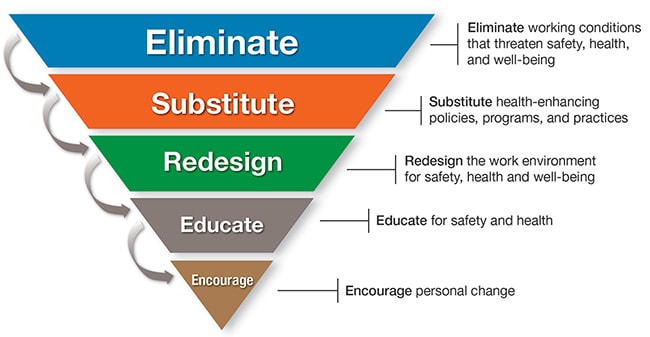Hierarchy of Controls Applied to NIOSH Total Worker Health®
A Total Worker Health (TWH) approach promotes a hazard-free work environment for all workers. The “Hierarchy of Controls Applied to NIOSH Total Worker Health®” provides a conceptual model for prioritizing efforts to advance the safety, health, and well-being of all workers. This applied model, which serves as a companion to the traditional Hierarchy of Controls used in occupational safety and health, expands on the existing one to include strategies that advance worker well-being. Like the traditional Hierarchy of Controls, controls and strategies are presented in order of expected effectiveness, from top to bottom.
Eliminating or reducing recognized hazards in the workplace is the most effective means of prevention and is the foundation of the TWH approach. While some hazards can be eliminated from the work environment, others, like shift work, are more difficult or even impossible to eliminate. These must be managed through engineering, administrative, or, as the very last resort, individual-level interventions. Workplace programs using a TWH approach should emphasize elimination or control of workplace safety and health hazards as the primary goal. Addressing environmental determinants of health rather than focusing on individual-level ones is a crucial concept for TWH programs.

Suggested Citation: NIOSH [20160. Fundamentals of total worker health approaches: essential elements for advancing worker safety, health, and well-being. By Lee MP, Hudson H, Richards R, Chang CC, Chosewood LC, Schill AL, on behalf of the NIOSH Office for Total Worker Health. Cincinnati, OH: U.S. Department of Health and Human Services, Centers for Disease Control and Prevention, National Institute for Occupational Safety and Health, DHHS (NIOSH) Publication No. 2017-112.
How to use this hierarchy
The “Hierarchy of Controls Applied to NIOSH Total Worker Health” emphasizes organizational-level interventions to protect workers’ safety, health, and well-being. To apply this model:
- First, eliminate workplace conditions that cause or contribute to worker illness and injury, or otherwise negatively impact well-being. For example, remove harmful supervisory practices throughout the management chain, if applicable.
- Second, replace unsafe, unhealthy working conditions or practices with safer, health-enhancing policies, programs, and management practices that improve the culture of safety and health in the workplace.
- Third, redesign the work environment, as needed, for improved safety, health, and well-being. Examples could include removing barriers to improving well-being, enhancing access to employer-sponsored benefits, and providing more flexible work schedules.
- Fourth, provide safety and health education and resources to enhance individual knowledge for all workers.
- Fifth, encourage personal behavior change to improve safety, health, and well-being. Assist workers with individual risks and challenges, while providing support in making healthier choices.
Examples of this hierarchy in practice
Using the “Hierarchy of Controls Applied to NIOSH Total Worker Health,” a program to reduce musculoskeletal disorders could:
- Eliminate workplace equipment that forces workers into damaging or unsafe positions to complete the task.
- Reorganize or redesign work to minimize repetitive movement and awkward postures.
- Provide ergonomic consultations to workers to improve job and workstation design. Offer ergonomic training and opportunities for workers to participate in design efforts.
- Evaluate the age profile and health needs of the workforce. Provide education on self-management strategies, such as preventive exercise to avoid arthritis or other musculoskeletal conditions.
A program to reduce work-related stress might:
- Implement organizational and management policies that eliminate root causes of stress, such as excess demands or workplace bullying, and that provide workers with increased flexibility and control over their work and schedules.
- Provide training for supervisors on successful approaches and strategies to reduce stressful working conditions.
- Provide training and interventions to build resiliency for stress management and reduction for all workers. Provide access to Employee Assistance Programs.

